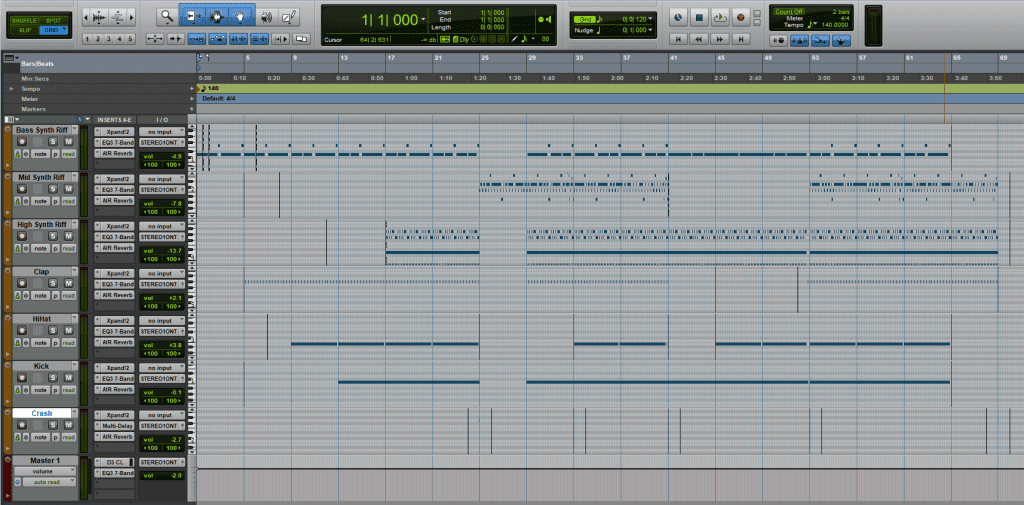
Dropz – The ProTools Session
Dropz is an interesting song because it is designed in a different way to the other songs in this EP. The initial bass is sequenced to play on the backbeats for the majority of the time, playing on the last two 16th notes of each beat (where 8th notes play twice as much as 4th notes in the same amount of time (which is what the kick drum is playing), 16th notes play twice as much as 8th notes, making one 4th note the equivalent of four 16th notes), so the sounds play after the first beat but just before the next one. Instead of using the bassline to help the drums keep rhythm, the bassline is more like a bass riff that repeats itself throughout the song (except on the drop), independent of what the drum kit does, because it provides a simple riff for the intro as well as a good lower frequency sound to fit around the drums throughout the remainder of the song.
The drums themselves are simple as well, with a typical Trance drum sound constructed with the help of this guide. For this, I used a ‘4 on the floor’ beat for the kick, a clap on every second beat, and hi-hats on every 8th note (so it plays twice as often as the kicks). Occasionally there is a crash cymbal after a build up/before a drop too. I decided to keep the drums simple for this piece as I didn’t want to create something too complex, which would make the song harder to dance to if it was played by a DJ, and instead I opted for a rhythmic, minimalistic kick drum that could keep the beat, sound punchy, and not get buried under all the other synths, with claps and hi-hats that controlled the higher frequencies to give the song a wide range of sound.
There are two more riffs included in this song: a mid synth riff for the drop, and a high synth for a more high pitched melodic riff, adding variety to the song without making it too complex or flooding the lower frequencies with noise. Both riffs repeat throughout the song, with the mid synth changing its pattern slightly towards the middle of the song and on the outro, removing some notes to make it even simpler. These were vital for this particular song because they both added extra layers of sound into the song, with one synth providing a harder-sounding sound for the drop while the other was used to help the build ups with its high pitched riff.

Dropz – The use of Velocity in the sequenced elements
Using velocity on this song helped to improve it a lot, as it added various tones and qualities to sound which gave it natural builds and drops. As seen on the image above, the High Synth Riff track used it a lot for build ups and on the outro. The effect of the velocity when it was lower made the synth riff sound softer, and as it increased, it allowed the sounds to get clearer, as if they were being played harder, similar to the notes on a piano. This meant that, especially in regards to all of the other tracks in the image above as well, each instrument could gain velocity at an automated rate which would help to build up tension, moving the song to a drop or a main section, or help the song get softer during an outro, and this is important because it allowed the flow of the song to change as it continued.
One other way that velocity was used was to show emphasis on particular sounds, especially on the Hi-Hat track. This was used to add some variety to the sound on the track, giving it a more human-like quality due to the sounds not being the exact same as one another, thanks to the varying velocities. The emphasis lay on the strikes on each beat, which was a logical choice as I wanted the hi-hats to work in tandem with the kick drum, in order to highlight where the beats were and help listeners keep time.

Leave a Reply